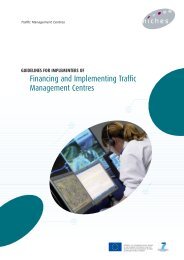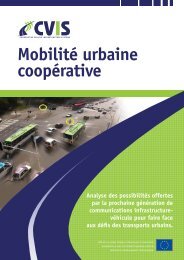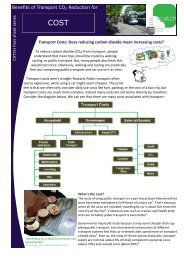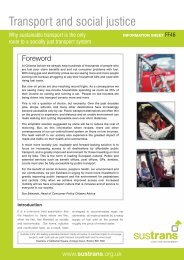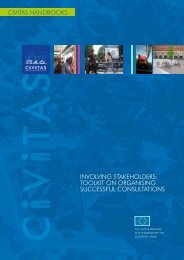EU funds for roads - CEDR
EU funds for roads - CEDR
EU funds for roads - CEDR
You also want an ePaper? Increase the reach of your titles
YUMPU automatically turns print PDFs into web optimized ePapers that Google loves.
Page 47 / 80<br />
- Where the conditions are right, the Commission is committed to providing budget support<br />
as a means to strengthen country ownership, finance national development strategies<br />
(including poverty reduction strategies), and promote sound and transparent public<br />
finances 63 .<br />
- Budget support<br />
64 involves the direct transfer of <strong>funds</strong> to a partner country’s budget,<br />
where they can be managed using national systems 65 .<br />
- Those receiving aid in this way must display sound macro-economic policies, and take<br />
steps to improve public financial management.<br />
2.2 How to secure <strong>EU</strong> <strong>funds</strong> <strong>for</strong> road projects<br />
The success of a body (being either a public authority, like a <strong>roads</strong> directorate, or a private<br />
company or person) in obtaining financial support from <strong>EU</strong> <strong>funds</strong> <strong>for</strong> its projects/operations,<br />
depends greatly on the body itself (supposing that there are <strong>EU</strong> <strong>funds</strong> available <strong>for</strong> <strong>roads</strong>, but<br />
there are many potential recipients eligible to receive them). A few recommendations <strong>for</strong><br />
success in this respect are outlined below:<br />
(a) Good preparation: This is obvious <strong>for</strong> all human activities. However, in order to access <strong>EU</strong><br />
<strong>funds</strong>, good preparation is a ‘condition sine qua non’ and a very critical issue since it<br />
requires time, ef<strong>for</strong>t, and money. This includes at the very least:<br />
<br />
<br />
The determination of one’s own needs: What projects do we want to implement in order<br />
to reach our objectives in the referenced period? What priority projects must we<br />
implement? Can we finance these projects with our own/national available <strong>funds</strong>? What<br />
<strong>funds</strong> do we need to secure from ‘external’ sources?<br />
The search <strong>for</strong> financial opportunities: Investigation of existing <strong>EU</strong> <strong>funds</strong> (financial<br />
instruments) and of the terms and conditions under which they provide their <strong>funds</strong>. Are<br />
there <strong>EU</strong> <strong>funds</strong> that might co-finance our projects (or parts of them)? What are the<br />
funding capabilities of the <strong>EU</strong> <strong>funds</strong> within the framework of potentially agreed axes of<br />
financing <strong>for</strong> priority sectors/cross-cutting issues or regions/areas? What other<br />
bodies/projects are likely (or certain) to compete <strong>for</strong> the same available <strong>funds</strong>? What is<br />
the possibility of succeeding in securing <strong>EU</strong> <strong>funds</strong> <strong>for</strong> (each of) our projects? What is the<br />
likely amount of funding that (each of) our projects could receive?<br />
63 To receive budget support, a partner country must meet certain eligibility conditions. These cover three main<br />
areas, which should be in place or under implementation:<br />
- a well-defined national or sectoral development or re<strong>for</strong>m policy and strategy;<br />
- a stability-oriented macroeconomic framework;<br />
- a credible and relevant programme to improve public financial management.<br />
64 There are two main types of budget support:<br />
- General budget support (GBS), representing a transfer to the national treasury in support of a national<br />
development or re<strong>for</strong>m policy and strategy.<br />
- Sector budget support (SBS), representing a transfer to the national treasury in support of a sector<br />
programme.<br />
65<br />
When transferred to the country, the <strong>EU</strong> <strong>funds</strong> <strong>for</strong>m part of the partner country’s global resources and are<br />
consequently used in accordance with its public financial management system. There<strong>for</strong>e, budget involves three<br />
key elements: (a) <strong>for</strong>eign exchange from the <strong>EU</strong> fund is transferred to the partner country’s central bank; (b) the<br />
central bank credits the country’s national treasury with an equivalent amount of local currency; (c) transfers by<br />
the <strong>EU</strong> fund to the central bank are made only after certain agreed conditions <strong>for</strong> payment are met.<br />
<strong>EU</strong> <strong>funds</strong> <strong>for</strong> <strong>roads</strong>






